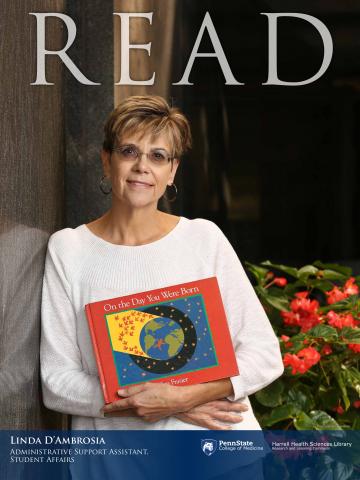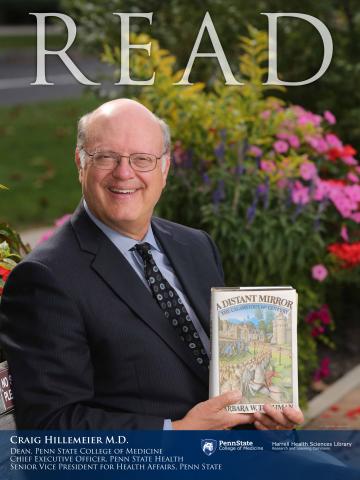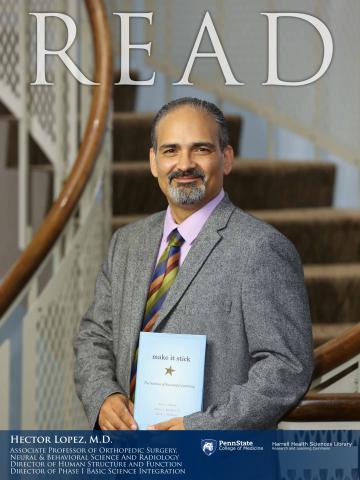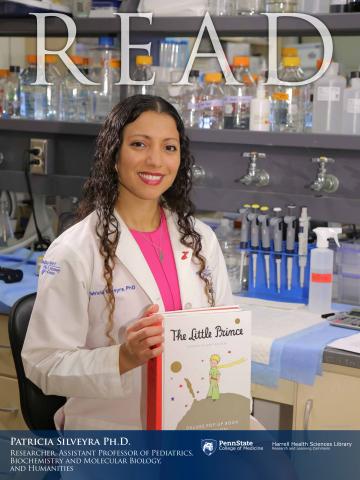Linda D'Ambrosia
Administrative Support Assistant, Student Affairs
On the Day You Were Born By Debra Frazier
Craig Hillemeier, M.D.
Chief Executive Officer, Penn State Health
Senior Vice President for Health Affairs, Penn State
A Distant Mirror By Barbara Tuchman
I chose “A Distant Mirror: The Calamitous 14th Century” by Barbara W. Tuchman. The book is a fascinating narrative of life in medieval times, including the impact of the 100-year war, the political and religious upheaval, the exploitation of different segments of society, and the bubonic plague that killed nearly a third of Europe’s population. I find that my favorite books are often those that chronicle history because they allow us to look back in time and realize that we, as human beings, tend to respond to situations in certain ways, whether that’s a war or political event or a tragedy. History really does repeat itself, and when we understand that, we can make more enlightened choices today. Looking back also helps us to realize that dark times eventually give way to hope.
Our purpose at Penn State College of Medicine and Penn State Health is to improve lives, and the Harrell Health Sciences Library empowers us to do that. Through its innovative technologies, labs, learning environments and staff, we can educate students in more meaningful ways, discover new knowledge that can improve how we prevent and treat diseases, provide better care to our patients and improve the health of our communities. The library inspires innovation that can make the world a better place.
Hector Lopez, M.D.
Associate Professor of Orthopedic Surgery, Neural & Behavioral Science and Radiology
Director of Human Structure and Function
Director of Phase I Basic Science Integration
Make it Stick: “The Science of Successful Learning” By Peter C. Brown, Henry Roediger III, and Mark McDaniel
As a medical educator, striving for excellence in understanding the intricacies of learning, I choose this book “Make it Stick: The Science of Successful Learning” by Peter C. Brown, Henry Roediger III, and Mark McDaniel. Do you remember those endless nights reading during college, opening a new pack of sticky notes and highlighters in multiple colors, marking sentence after sentence, codifying what was more or less important? It turns out that this is the least effective way to learn from books. The book's premise is that short-term and long-term memory are two different entities, that what we're trying to achieve when we say "I’m learning" is based heavily on the works of our long-term memory and recall of facts rather than relying on short-term memory to do all the work. The goal of Make It Stick is to apply empirical scientific research to the dilemma of good learning, specifically, retention of information for later use and avoiding cramming as a strategy for long-term success.
This book helped me to take advantage of a method of “learning” that is more challenging interleaving but results in an improved long-term understanding. Concepts like interleaving, desirable difficulties, and forcing yourself to interpret and analyze material instead of re-reading are some of many topics discussed in this book. If you want to expand your understanding of teaching and learning I have three words: Read this book!! Do it with enthusiasm, and for the love of learning.
Timothy Mosher, M.D.
Kenneth L. Miller Chair of Radiology
Distinguished Professor of Radiology and Orthopaedics
Walden By Henry David Thoreau
“I went to the woods because I wished to live deliberately, to front only the essential facts of life, and see if I could not learn what it had to teach, and not, when I came to die, discover that I had not lived.”- Walden, Henry David Thoreau 1854
Ira Ropson, Ph.D.
Director, Medical Student Research
Associate Professor, Biochemistry and Molecular Biology
The Lord of the Rings By J.R.R. Tolkien
Libraries have always been one of my favorite places. I grew up on a farm in Northeastern Wisconsin, where the local was a single crossroad with a bar, a milk processing plant, a church and a farmhouse on the four corners. Although the countryside was beautiful, the daily repetitive labor of farm life was not enough for the “smart” kid. The local grade school library selection was very sparse, but fortunately every Tuesday afternoon the Bookmobile (a recreational vehicle full of books) parked in the school parking lot. I would check out the maximum of three books every week. I was interested in everything - especially in science, which led to me to science fiction, then to fantasy. I chose the Lord of the Rings as my book because of the rich language, with the feeling that you could imagine what the entire world looked like and that even the most mundane existence could become magical and important. As a scientist, I continue to be amazed at the complexity of life and how little knowledge we actually have. The library continues to be a starting place for understanding, imagination, and technology.
Patricia Silveyra, Ph.D.
Researcher
Assistant Professor of Pediatrics, Biochemistry and Molecular Biology, and Humanities
The Little Prince By Antoine de Saint-Exupéry
The first time I read this book I was only six years old. I lost count on how many times I went back to it. Every time I read it, I learn something new. Every time I finish it, I find myself viewing the world with a different set of eyes. I have to admit that every time I learned a new language, I went back to it, just to see how does “El principito”, “The little prince”, “Le petit prince”, or “O pequeno príncipe” feels like. Perhaps I am curious to see how every message is interpreted by the translator. A fun fact I learned while preparing this summary is that this is one of the most-translated books in the world!
Even though “The little prince” is supposed to a kids’ book, it offers some of the most valuable life lessons one can get. This book has taught me to think outside of the box, to value my creativity, to get out of my comfort zone, and to appreciate the little things. As a scientist, I rely on those lessons to find answers to my research questions, to interpret experimental results, and to lead my laboratory team. The Harrell library does something similar. Visiting it inspires me. I use the library online resources almost daily when I need to find information or prepare for a class, but I also often sit on its desks to write a manuscript or a grant proposal, while I remain amazed at the technology that surrounds the books on the shelves. I still remember the first day I walked into it almost 10 years ago, and my first thought was “wow, these students are so lucky!” I have been fortunate enough to observe the library’s recent renovations and transformations, and how quickly it adapted to the student’s needs. I was also fortunate to be one of the first users of the one-button studio, which was incredibly helpful for the communication of my work and outreach activities. I can’t wait to see what the future holds for our amazing library!





